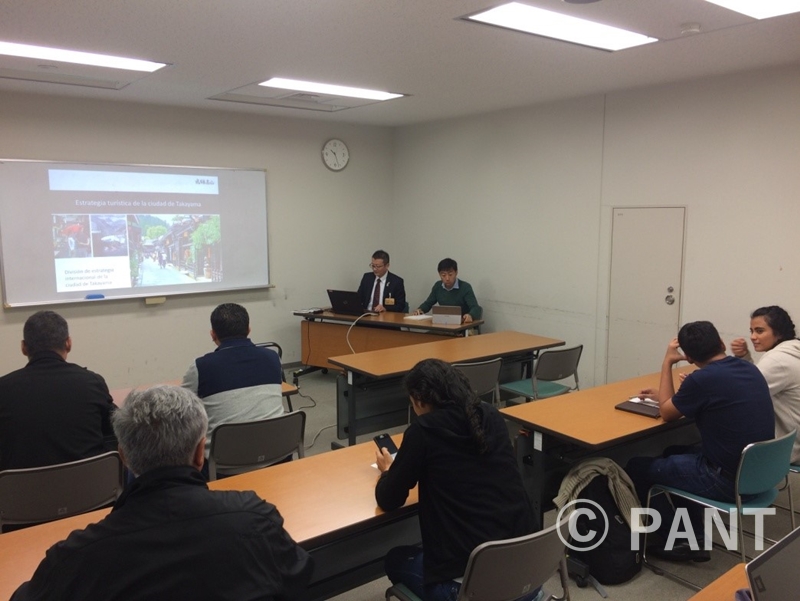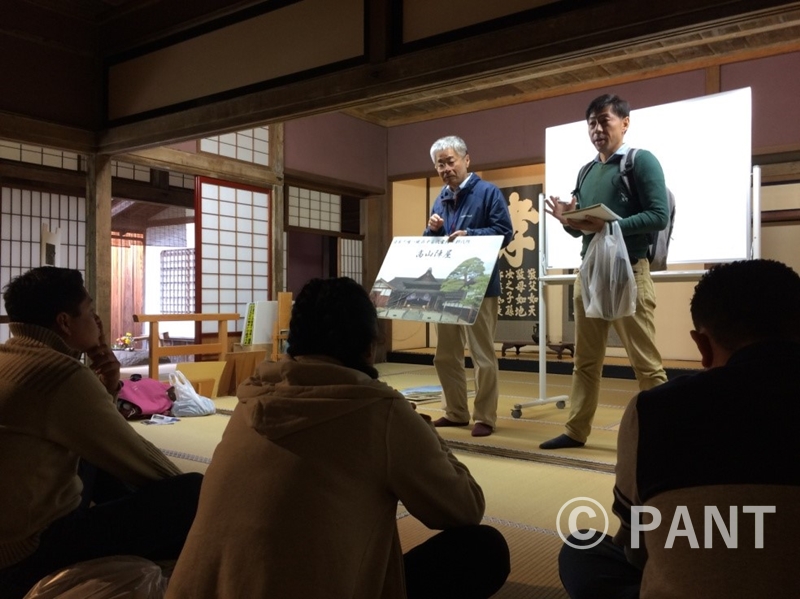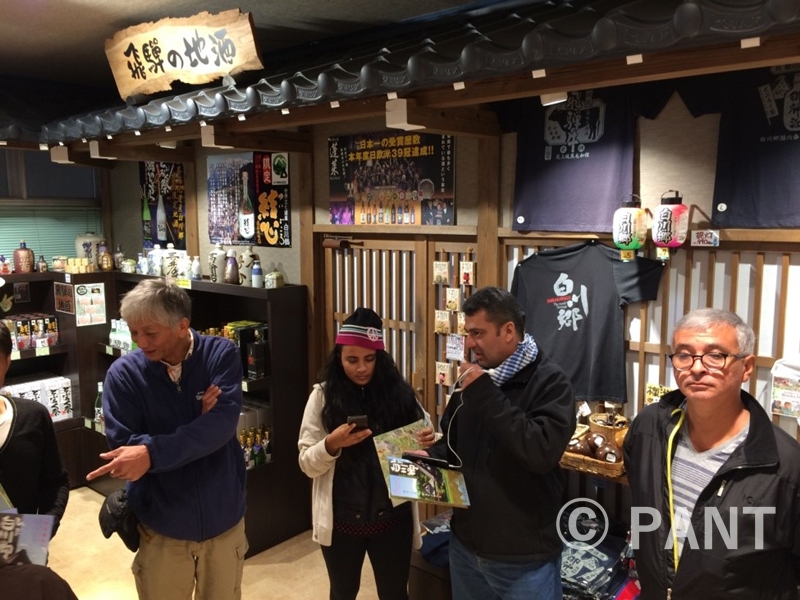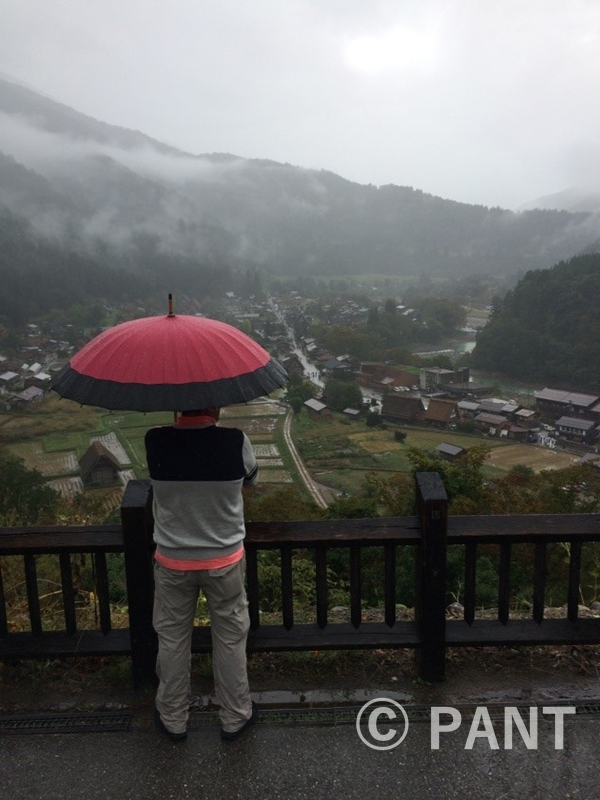Trainees report:Kanazawa Training Program:October 13-14, 2019
Miguel Ángel Echeverría Tager
(2019/10/15)
Right after the typhoon went by Japan and flooded some towns in the southeast, we hit the road and went to Takayama accompanied by Ms. Risa Ogata and Mr. Alejandro Falla. We had experienced de bullet train, but this was our first time on the highways over four wheels. Japanese highways, Mr Cristian Aguilar, the trainee from Honduras noted, are not meant for touristic roadtrips. You need to go to the town that lies on the other side of the mountains, what do you do? We would have searched for the best mountain pass to lay down a highway to go up the mountain and then go down on the other side. The Japanese just build a tunnel through the mountain. For us, coming from mountainous countries, going through a mountain and in no time reaching the other side was a novelty. On our way back, though, we wished we could have been able to see the sunset from up high and not just imagine it from the tunnel.
When we reached Takayama, Mr. Hiroaki Hatarajiri from the city´s prefecture led us through the City Hall and delivered an introductory presentation of the touristic strategy of the city of Takayama. He began his presentation with the statistical projection of population decrease and economic growth. Unlike Guatemala City, Takayama is a city that is facing a decrease in its population. A common situation throughout Japan and a problem that local authorities have to think in advance, the touristic strategy they adopted is the main face of a plan to cope with this situation.

Mr. Hiroaki Hatarajiri explaining Takayama´s tourism policies
The presentation continued with pictures and explanations of the touristic attractions that Takayama has to offer. Cultural attractions, natural attractions and gastronomical attractions were at the top of the list.
The first place we visited was the Takayama Jinya, a monumental government building in the list of National Historical Monuments. Its historical value lies not only within the building itself, but in the collection of documents that it possesses. Having been the cede of governmental authority in this region during the Edo period, the Takayama Jinya keeps records of judicial processes and tax records that are of great value to the person interested in history. We were not able to read Japanese, but the guide in charge of the tour read some documents that the translator delivered to us in Spanish. The one that shocked us the most was a farewell letter of a person condemned to the guillotine for leading an uprising. In quite an impassible tone, the condemned expresses his love for his wife and his family and accepts his punishment as if it were an honor. I could not help thinking about the cultural gap that separates East and West, but I could also not help thinking that right at the heart of Western Culture lie stories about Greek heroes —and a particularly special Jew— who faced their destinies, even if that meant death.

Mr. Toru Taki translating the explanation of the tour guide to the Takayama Jinya
One place that I had been wishing to visit was a Shinto Temple, and even if I had already been to one on my own, I wanted all the other trainees to have that experience. Right after having Hida beef for lunch —one of the specialties that was advertised as a gastronomical attraction for tourists— at a quaint little restaurant on a not so crowded street in Takayama´s downtown, Ms. Risa Ogata took us to a visit one. She explained to everyone the ritualistic washing of hands and mouth before entering and the summoning of the temple´s deity by clapping twice before praying. Some of the trainees even ventured further than this ritual to ask for their luck after depositing a coin in a box. For some of the trainees with very deep catholic roots, having the opportunity to acknowledge the fact that other religions —religions radically different from Christianity— exist with the same rights, was a revelation. In my opinion, it was a very positive opportunity for personal growth.

Ms. Risa Ogata trailing the group of trainees as they climb the stairs of the Jinja Haguman Shrine
The second day of our trip took us to the town of Shirakawa-go right on time for the Doburoku festival, a festivity full of traditional music and traditional dancing warmed with a special type of sake prepared specially for this occasion.
We stopped first at the Shirakawa Michinoeki, the resting area for visitors, the antechamber to the town of Ogi-machi in Shirakawa-go. As one of the trainees, Mr. Carlos González, noted when we went through this place on our way back, the location of this stop is most conveniently located in front of a Shinto Temple and in a spot where the village just cannot be seen yet: a touristic spot that just teases the visitor and enhances his anxiety. We stopped there for short tour of a small museum and where a gassho-style cabin is presented with all the stages of its construction. The tour guide of the museum explained to us how these cabins were made and how they now take meticulous care to preserve them. Just like the first western architect that set his eyes in these houses, we were also surprised to notice the creative and absolutely logical solutions the Japanese found for housing. We had seen beautifully hand-wrought nail-head covers in the samurai house we had visited, and we had spotted them in most of the historical buildings we had visited, but his time we couldn´t see any. One of the fellow trainees and me were just about to comment on this fact we had noticed when the tour guide, as if he were reading our minds through the language barrier, explained that no nails are used in the construction of a gassho cabin: everything is tied with ropes made out of natural fibers that are grown specifically for that purpose. No nails, no adhesives: most impressive. And the roofing that could withstand a winter on the mountains and provide a fresh night’s sleep during hot summers is itself an achievement.

The group of trainees at the Shirakawa Michino-Eki hearing an explanation from the guide to the Gassho Zukuri museum
The village of Shirakawa-go is the most beautiful place we have visited so far. The first glimpse we caught of this village in a river valley surrounded by mountains is an image none of us will forget. It was raining, clouds were hanging low on the sky, the profile of the mountains was just insinuated, and the green river meandering along the town was more beauty than what we expected. We had seen the pictures in presentations, in magazines, but the actual experience of standing under the rain in a deck on a mountaintop with a full view of the valley surpassed them all.

One of the trainees, Mr. Cristian Aguilar, standing under the rain and watching the town of Ogi-machi
To see the actual houses, we visited the Wada House, a house that belongs to the Wada family and is open to the public for touristic purposes. Besides having the opportunity to take a close look at an authentic gassho house, we could see part of the private life of a Japanese household. We could see the kitchen, the Buddhist and the Shinto shrines that welcomed visitors, and even an exhibition of cases where they used to keep silkworms in the attic.
After visiting the Wada House, we went directly to the site of the Doburoku Festival, the area of the main Shinto Shrine in Ogi-machi. Traditional dances, music never heard before by our ears, exotic costumes and make-up, all sorts of seafood being cooked out on the streets, rain pouring down: it all overflowed our brains´ capacity. Now that I think back on it, the cups of sake that Mr. Tatsuya Ozaki offered us might have had something to do with it (although some of us did not get past the first cup we courteously accepted). Walking back to the bus that would drive us to Kanazawa, Mr. Carlos González commented that festivals such as the one we had just attended would be impossible in Guatemala. Imagine a festival where you get unlimited refills of your cup —sake or in our case beer or rum. Impossible in Guatemala where everyone drinks until he is wasted! Only one person did we see completely drunk, only one among the many hundreds of attendants that were having sake by the barrel.
